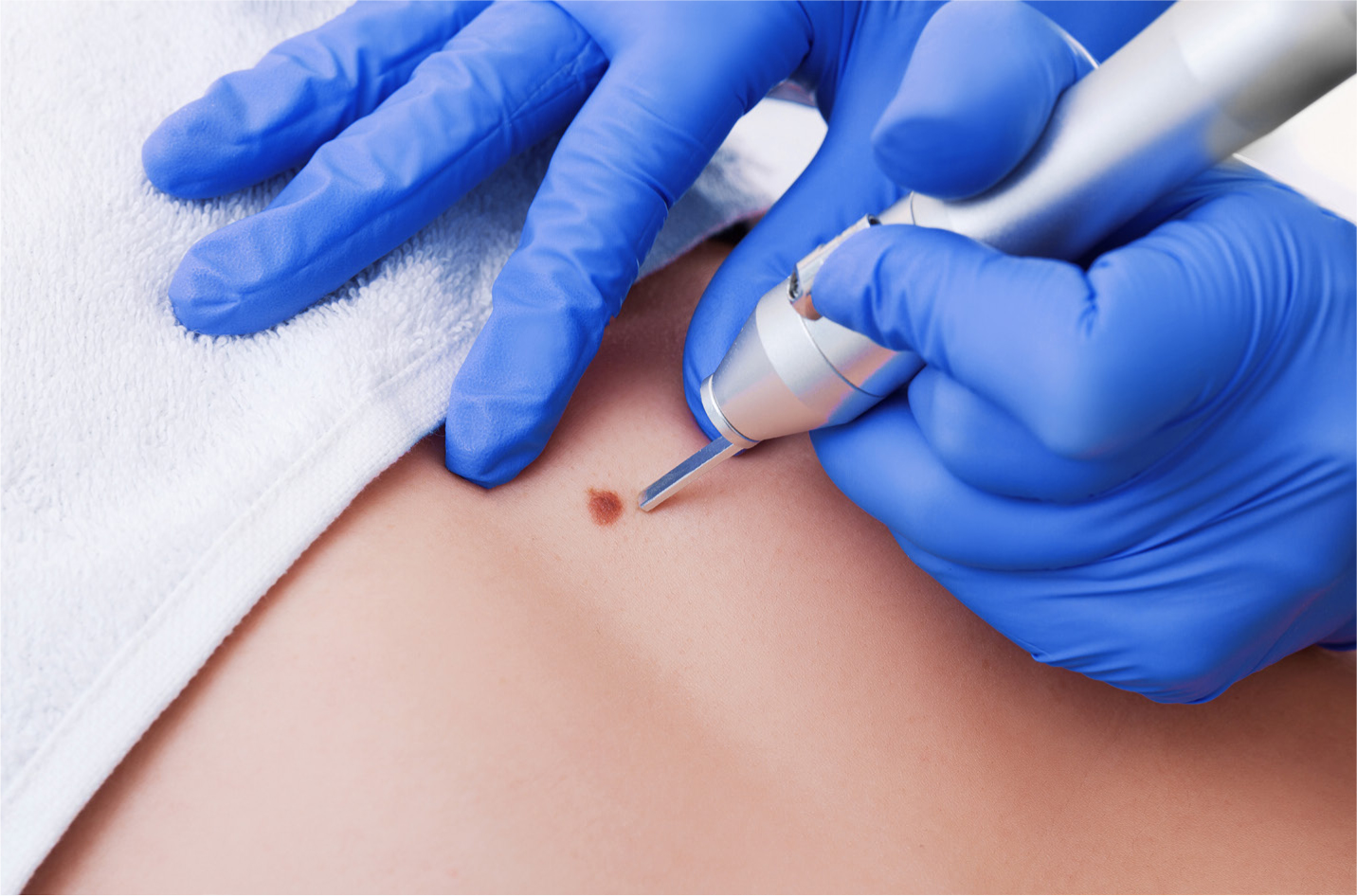
 Before treating any lesion with cryotherapy, a diagnosis needs to be obtained by a qualified clinician
Before treating any lesion with cryotherapy, a diagnosis needs to be obtained by a qualified clinician
Cryotherapy is the use of cold in a medical setting to treat a variety of tissue lesions. It is usually delivered by a cryoprobe or spray connected to a reservoir of liquid nitrogen. This is at a temperature of −196°C. Using an open spray of liquid nitrogen creates an ice ball, the depth of which is roughly equal to the lateral spread. Some cells, such as melanocytes, are easily damaged by cold, whereas others, such as fibroblasts, are very resistant to cold (Yiu et al, 2007). The efficacy of liquid nitrogen and guidelines for treatment are well established (Cooper and Dawber, 2001). Other methods of delivering cryotherapy are Histofreeze and Dermafreeze, which employ vaporisation of a volatile liquid to create cooling and nitrous oxide as a CryoPen (HO Equipment).
 Cryotherapy can be used to treat both benign and premalignant lesions
Cryotherapy can be used to treat both benign and premalignant lesions
» Hypopigmentation is common in cryotherapy, and care should be taken, especially in darker skinned patients, as changes in pigmentation may be permanent, and this can lead to litigation if the patient did not consent or was not treated properly «
Treatment spectrum
Cryotherapy can be used to treat benign lesions, such as viral warts, seborrheic keratosis, sebaceous hyperplasia, haemagiomas and lentigo, and premalignant lesions, such as actinic keratosis and Bowen's disease. It can also be an effective treatment for keloid scars.
The spectrum of possible treatable lesions is wide, but cryotherapy is not always the treatment of choice. Lasers are an alternative, but are a more expensive choice for both the patient and the aesthetic practitioner. Topical therapies can also be employed, and these are useful in patients with scattered lesions that are present in large numbers, for example, treating actinic keratoses with zonal 5 FU (National Institute for Health Research, 2019). However, topical agents can be slow to produce results and rely on patient compliance.
Warts and verrucas may seem unglamorous, but there are patients who wish to have these treated. Treating solar lentigo with cryotherapy is considered by some authors to be the treatment of choice (Ortonne et al, 2006). Seborrheic keratosis and sebaceous hyperplasia also respond well to cryotherapy (Wood et al, 2013; Ataş and Gönül, 2017), and these are the mainstay of the author's clinical activity.
Other lesions, such as keloid scars, can be treated with cryotherapy, in addition to steroid injection, which has proven effective (Shamsi Meymandi et al, 2016), and the author uses this method of treatment in his clinic.
Advantages and disadvantages
Advantages of the liquid nitrogen system are that it is very cold and it is versatile. However, the disadvantage is that it requires a large storage dewar and an appropriate safe space to store it, as well as regular deliveries of liquid nitrogen. Other devices are ready to hand and less expensive, but they do not deliver the cooling effect of liquid nitrogen. It is debatable whether liquid nitrogen is crucial in treating mainly benign lesions in an aesthetic clinic; however, the general impression is that liquid nitrogen is more efficient (Unger, 2017).
Potential dangers of cryotherapy
Many aesthetic clinics provide some form of treatment using a freezing device. Spraying an unknown lesion with a cryotherapy spray may be perceived as being simple, as it invariably changes and often disappears. However, there can be issues with treating lesions with cryotherapy: it may alter their histology. Reports of this occurring have been published in medical journals (Adeniran et al, 2009). Furthermore, if the lesion has disappeared, the patient may not seek further intervention for something that is potentially fatal. Therefore, the author considers treating a lesion with cryotherapy without a diagnosis to be medically indefensible. Before treating any lesion, a diagnosis needs to be obtained by a qualified clinician. Pigmented lesions would be considered higher risk in regard to cryotherapy treatment.
Once diagnosis is obtained and the patient determined as suitable for treatment, the practitioner can proceed with the cryotherapy treatment. Informed consent needs to be obtained, and the side effects of cryotherapy clearly outlined. These side effects are detailed in the British Association of Dermatologists (BAD) patient information leaflet (BAD, 2018), which the author issues to patients.
The side effects of cryotherapy are:
- Pain: cryotherapy is usually well tolerated, but it can sometimes be painful if a deep freeze has been necessary (i.e. to treat a basal cell carcinoma). This discomfort can occur both at the time of treatment and for a variable time thereafter. Painkillers (such as paracetamol) taken for the first 24 hours may relieve the discomfort; also taking a painkiller an hour or so prior to the anticipated treatment may reduce the discomfort.
- Swelling and redness: this is a normal immediate response to freezing the skin, and it usually settles after 2–3 days. For a short while, the treated area may ooze a little watery fluid. Cryotherapy close to the eyes may induce prominent puffiness of the lower eyelids that settles within days.
- Blistering: this is also a common consequence of cryotherapy, and blisters settle after a few days, as the scab forms. Some people blister more easily than others, and the development of blisters does not necessarily mean that the skin has been frozen too much. Occasionally, the blisters may become filled with blood; this is harmless and should only be punctured if a blister is painful and very uncomfortable, using a sterile needle. Seek advice from a GP or the practitioner who performed the treatment before doing this.
- Infection: uncommonly, infection can occur, resulting in increased pain and the formation of pus—this may require topical antiseptic or antibiotic therapy from the practitioner who performed the treatment or a GP (BAD, 2018).
» Storage and handling of liquid nitrogen is straightforward, and if there is a safe, locked and vented area, it is reasonable to store the dewar there. Filling the probe reservoir requires gloves and eye protection, but it is quick and simple «
Furthermore, subsequent side effects include:
- Scarring: rarely, a scar will form, especially if a deep freeze has been necessary (i.e. to treat a basal cell carcinoma).
- Hypertropic/keloid scarring: very rarely, a raised scar can form following treatment with cryotherapy, which appears as a rounded, hard growth on the skin. These are harmless lesions, more common in dark-skinned individuals compared with Caucasians.
- Pigmentation changes: the skin at and around the treatment site may lighten or darken in colour, especially in dark-skinned patients. This usually improves with time, but it may be permanent.
- Numbness: if a superficial nerve is frozen, it may result in numbness of the area of skin supplied by that nerve. Normal feeling usually returns within a matter of months. Treatment may not be effective, or the condition may recur.
Discussions and consent
Hypopigmentation is common in cryotherapy, and care should be taken, especially in darker skinned patients, as changes in pigmentation may be permanent, and this can lead to litigation if the patient did not consent or was not treated properly. Care when treating near the eyes and lips is especially important.
Once consent is obtained, it is useful to apply an anaesthetic cream and de-bulk hyperkeratotic lesions before treatment. It does sting when the treatment is applied, and patients need to be warned of this. This is particularly the case when treating warts and molluscum contagium in children. These are self-limiting lesions, but, sometimes, parents are eager for their child to be treated. A discussion regarding treating a self-limiting lesion with a painful treatment needs to be had prior to treatment.
There is a variety of ways to use liquid nitrogen, and the kits supplied usually have a variety of nozzle sizes. Furthermore, it is useful to use the disposable ear cones that come with otoscopes, as they can be cut to a lesion size to funnel the spray. The lesion is sprayed from about 1 cm away until an ice ball forms around the lesion, and this should be maintained for the number of seconds required in the protocol (Dowber et al, 1997). The author uses feathering to blend the edges of the treatment area, and this is important for pigmented lesions in particular. With most benign lesions, a single freeze–thaw cycle is all that is required. Other methods that can be used are cotton buds and artery forceps dipped in liquid nitrogen or a solid probe that contacts the lesion directly. Repeat treatment intervals may vary, and there is a protocol referenced by Dowber et al (1997).
Many lesions take more than one cryotherapy treatment to resolve. Patients need to be warned of this and consented appropriately. An appropriate pricing structure is required to reflect this. Open-ended treatment schedules can create further difficulties, both medically and commercially, for a variety of reasons, and they are best avoided.
Setting up a cryotherapy service
Setting up a proper cryotherapy service takes some consideration. Purchasing a dewar and probe costs approximately £2000, and annual deliveries of liquid nitrogen are around £500. After the initial consultation of approximately 20 minutes, follow-up consultations take around 15 minutes. The author uses a dermatoscope and makes a clinical diagnosis of the lesion prior to treatment, but this is not an option for everyone, as many aesthetic practitioners may need the patient to be diagnosed before the treatment by a qualified clinician.
Storage and handling of liquid nitrogen is straightforward, and if there is a safe, locked and vented area, it is reasonable to store the dewar there. Filling the probe reservoir requires gloves and eye protection, but it is quick and simple. A good protocol for storage has been compiled by the Northern Devon Healthcare NHS Trust (2016), which can be referred to. Health and safety is paramount, and it is best for practitioners to ensure that they are compliant before considering opening the service. The Health and Safety Executive can also advise clinicians if further advice needs to be obtained.
Training on the various uses of cryotherapy using live patients is quite difficult to obtain, but experienced practitioners may be willing to provide this. In the author's experience, the key element is correct diagnosis, followed by careful treatment. For instance, treating a lentigo carelessly can leave a hypomelanotic centre with a dark rim of pigmentation. In the end, it comes down to clinical judgement, and this involves understanding how the treatment works and how tissue heals.
Conclusion
Cryotherapy has shown to be a well-established treatment for a variety of benign and some pre-malignant and malignant skin lesions. It is cost-effective and relatively easy to perform. However, it is essential that the patient has a medical diagnosis before embarking on treatment. As with any destructive treatment, there are risks—in particular, hypopigmentation—so it should be used with care.



